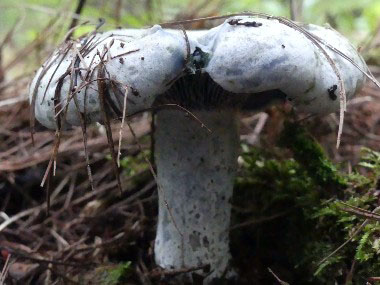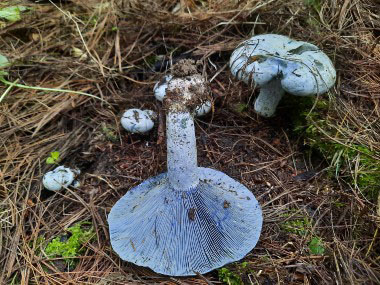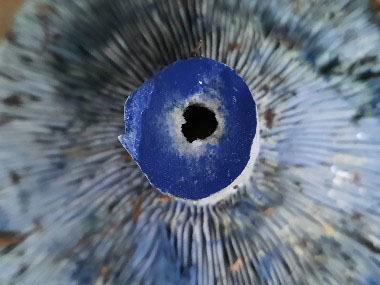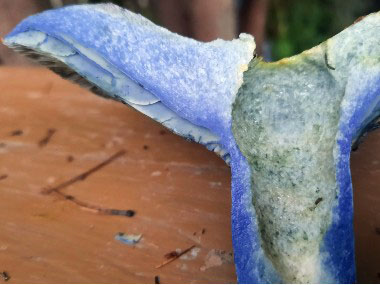






Do not eat any fungi that has not been properly identified by a qualified professional, some are DEADLY when ingested. All edible wild fungi MUST be cooked.
Lactarius indigo, commonly known as the indigo milk cap, the indigo (or blue) lactarius, or the blue milk mushroom, is a species of agaric fungus in the family Russulaceae. There is no mistaking this mushroom as it is a truly remarkable, blue mushroom that exudes dark blue milk when damaged with a knife. Only Lactarius chelidonium and Lactarius paradoxus come close in appearance--and they only do so when very young, before they have begun to develop their brown and yellow shades (and they also have yellowish and brown milk, respectively). This mushroom grows in well over one hundred countries and it is generally quite easy to spot. Indigo milk caps are known to reappear in the same area for many years.
Type
Distinguishing Features
This is a strikingly unique mushroom that is bluish, bleeds blue when cut; then turns somewhat greenish or bruises greenish. The cap is convex to sunken, with an inrolled margin at first; indigo blue when fresh, fading to pale grayish blue with deep greenish bruises. It has a sticky, yet smooth texture. The latex deep indigo blue becomes dark green with exposure to air.
Height
The stems grow 2 to 8 cm (3/4 to 3 1/2") long and 1 to 2.5 cm (1/4 to almost 1") thick. The stem is equal or tapers to the base and sometimes is a little off-centre. It is slimy at first but quickly dries, becomes hollow, and sometimes has pockmarks on the stem.
Habitat
Grows scattered or in groups on soil mostly (but not exclusivly) in oak and pine woods. Indigo Milk Caps are a well-known edible and common fungus with a vast population globally. It has been widely and frequently observed in 137 countries.
Spore Print
Spore print is cream. When magnified, spores are broadly elliptical to round.
Season
July to October depending on location.
Gills
Gills are attached, broad, and the spacing is close. They are dark blue, becoming paler, staining blue-green when bruised.
Edibility
Lactarius indigo is edible, be sure to cook it if fresh. When cooked it often stains green and will stain whatever it is cooked with as well. The flavour is similar to a portobello when cooked, but with a grainier texture. It dehydrates well for later uses. This mushroom is often sold in China and Central America. In addition to being edible, its bright blue pigment has been used for a variety of uses, including as a basis for fluorescent pigments.
Other Name
Blue lactarius.
Recipes
To support our efforts please browse our store (books with medicinal info, etc.).
Winter Survival Food Handbook

PDF Plant Magazines
Types of Wild Food
Geographic Zones Seasons
Disclaimer
EdibleWildFood.com is informational in nature. While we strive to be 100% accurate, it is solely up to the reader to ensure proper plant identification. Some wild plants are poisonous or can have serious adverse health effects.
We are not health professionals, medical doctors, nor are we nutritionists. It is up to the reader to verify nutritional information and health benefits with qualified professionals for all edible plants listed in this web site. Please click here for more information.
Why Edible Wild Food?
- Food costs are rising
- Free, wild food is readily abundant
- Wild food adds nutrition to your diet
- Wild food can help treat various medical conditions







